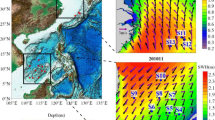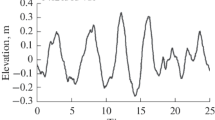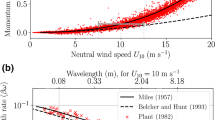Abstract
Based on the equations of motion and the assumption that ocean turbulence is of isotropy or quasi-isotropy, we derived the closure equations of the second-order moments and the variation equations for characteristic quantities, which describe the mechanisms of advection transport and shear instability by the sum of wave-like and eddy-like motions and circulation. Given that ocean turbulence generated by wave breaking is dominant at the ocean surface, we presented the boundary conditions of the turbulence kinetic energy and its dissipation rate, which are determined by energy loss from wave breaking and entrainment depth respectively. According to the equilibrium solution of the variation equations and available data of the dissipation rate, we obtained an analytical estimation of the characteristic quantities of surface-wave-generated turbulence in the upper ocean and its related mixing coefficient. The derived kinetic dissipation rate was validated by field measurements qualitatively and quantitatively, and the mixing coefficient had fairly good consistency with previous results based on the Prandtl mixing length theory.
Similar content being viewed by others
References
Yuan Y L, Qiao F L. Ocean dynamical system and MASNUM numerical model system (in Chinese). Prog Phys Geogr, 2006, 16: 1257–1267
Yuan Y L, Qiao F L, Yin X Q, et al. Establishment of the ocean dynamic system with four sub-systems and the derivation of their governing equation sets. J Hydrodyn, 2012, 24: 153–168
Gill A E. Atmosphere-Ocean Dynamics. New York: Academic Press, 1982
Kamenkovich V. Fundamentals of Ocean Dynamics. Amsterdam: Elsevier Science, 1977
Phillips O M. The Dynamics of the Upper Ocean. Cambridge: Cambridge University Press, 1977
Wunsch C, Ferrari R. Vertical mixing, energy, and the general circulation of the oceans. Annu Rev Fluid Mech, 2004, 36: 281–314
Mellor G L, Yamada T. Development of a turbulence closure model for geophysical fluid problem. Rev Geophys Space Phys, 1981, 20: 851–875
Shi X G. Turbulence (in Chinese). Tianjin: Tianjin University Press. 1994
Baumert H Z, Simpson J H, Sundermann J, et al. Marine Turbulence: Theories, Observations and Models. Results of the CARTUM Project. Cambridge: Cambridge University Press, 2005
CARTUM Project 1999–2001. The Comparative Analysis and Rationalization of Second-moments Turbulence Model (CARTUM) Project supported by the European Commission’s Marine Science and Technology (MAST)
Jone W P, Launder B E. The production of laminarization with a two-equation model of turbulence. Int Heat Mass Tran, 1972, 15: 301–304
Osborn T R. Estimates of the local rate of vertical diffusion from dissipation measurements. J Phys Oceanogr, 1980, 10: 83–89
Yuan Y L, Hua F, Zhang S W, et al. Statistical model on the surface elevation of waves with breaking. Sci China Sre D-Earth Sci, 2008, 51: 759–768
Yuan Y L, Han L, Hua F. The statistical theory of breaking entrainment depth and surface whitecap coverage of real sea waves. J Phys Oceanogr, 2009, 39: 143–161
Huang C J, Qiao F L. Wave-turbulence interaction and its induced mixing in the upper ocean. J Geophys Res, 2010, 115: C04026
Anis A, Moum J N. Surface wave-turbulence interactions: Scaling s(z) near the sea surface. J Phys Oceanogr, 1995, 25: 2025–2045
Wüest A, Piepke G, Van Senden D C. Turbulence kinetic energy balance as a tool for estimating vertical diffusivity in wind-forced stratified waters. Limnol Oceanogr, 2000, 45: 1388–1400
Yuan Y L, Qiao F L, Hua F, et al. The development of a coastal circulation numerical model: 1. Wave-induced mixing and wave-current interaction (in Chinese). J Hydrodyn Ser A, 1999, 14: 1–8
Qiao F L, Yuan Y L, Ezer T, et al. A three-dimensional surface wave-ocean circulation coupled model and its initial testing. Ocean Dynam, 2010, 60: 1339–1355
Author information
Authors and Affiliations
Corresponding author
Rights and permissions
About this article
Cite this article
Yuan, Y., Qiao, F., Yin, X. et al. Analytical estimation of mixing coefficient induced by surface wave-generated turbulence based on the equilibrium solution of the second-order turbulence closure model. Sci. China Earth Sci. 56, 71–80 (2013). https://doi.org/10.1007/s11430-012-4517-x
Received:
Accepted:
Published:
Issue Date:
DOI: https://doi.org/10.1007/s11430-012-4517-x




